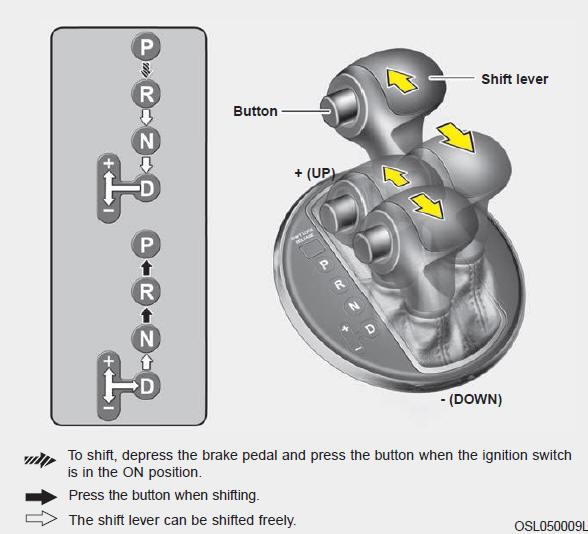 Kia Sportage: Automatic transaxle operation
Kia Sportage: Automatic transaxle operation

The automatic transaxle has 6 forward speeds and one reverse speed. The individual speeds are selected automatically, depending on the position of the shift lever.
✽ NOTICE
The first few shifts on a new vehicle, if the battery has been disconnected, may be somewhat abrupt. This is a normal condition, and the shifting sequence will adjust after shifts are cycled a few times by the TCM (Transaxle Control Module) or PCM (Powertrain Control Module).
For smooth operation, depress the brake pedal when shifting from N (Neutral) to a forward or reverse gear.
![]() WARNING - Leaving the vehicle
WARNING - Leaving the vehicle
Before leaving the driverŌĆÖs seat, always make sure the shift lever is in the P (Park) position; then set the parking brake fully and shut the engine off. Do not use the P position in place of the parking brake. Always make sure the shift lever is latched in the P position and set the parking brake fully. Unexpected and sudden vehicle movement can occur if these precautions are not followed.
![]() CAUTION - Transaxle
CAUTION - Transaxle
To avoid damage to your transaxle, do not accelerate the engine in R (Reverse) or any forward gear position with the brakes on. The transaxle may be damaged if you shift into P (Park) while the vehicle is in motion.
When stopped on an incline, do not hold the vehicle with the engine power. Use the service brake or the parking brake.
 Transaxle ranges
Transaxle ranges
The indicator in the instrument cluster displays the shift lever position when
the ignition switch is in the ON position.
P (Park)
Always come to a complete stop before shifting into P (Park). Thi ...
Other Information:
Manifold Absolute Pressure Sensor (MAPS): Repair procedures
Inspection
1.
Connect the GDS on the Data Link Connector (DLC).
2.
Measure the output voltage of the MAPS at idle and IG ON.
Specification: Refer to "Specification"
Removal
1.
Tur ...
Closing the hood
1.Before closing the hood, check the following:
All filler caps in the engine compartment must be correctly installed.
Gloves, rags or any other combustible material must be removed from the
...
Categories
- Home
- Kia Sportage QL (2015-2019) Owners Manual
- Kia Sportage QL (2015-2019) Service Manual
- Kia Sportage SL 2010-2016 Owners Manual
- Kia Sportage SL 2010-2016 Service Manual

